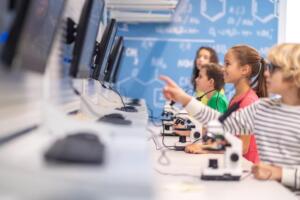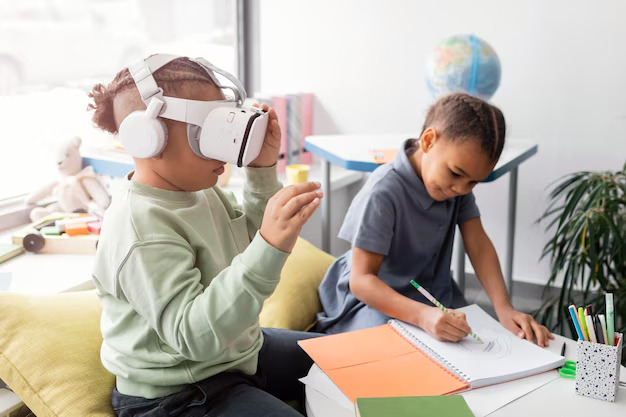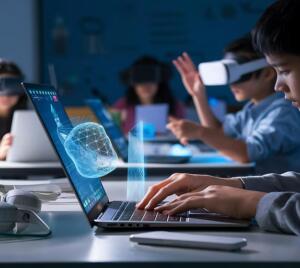There’s no stopping the rapid tech advancements of today’s world and AI is absolutely everywhere. But much more than just a tech tool, educators should be looking to AI as a real gamechanger, because finally there’s an accessible way to reshape how we teach and learn. With a surge of information at our fingertips and the push for personalised learning, AI now gives educators a powerful set of tools to overhaul their teaching methods.
In this article, I’ll look into how teachers can use this technology to efficiently create teaching resources that are effective and also personalised for everyone’s needs. Despite any fear mongering, AI in education doesn’t involve gadgets or robots taking over classrooms, rather it’s about reimagining how we teach and learn in ways that could blow our minds.

Personalised Learning: It’s Like Netflix, But for Your Brain
Remember how Netflix changed the game with its “recommended for you” feature? Well, now imagine that same concept, but for learning. AI is making it possible to create personalised learning experiences that adapt to each student’s needs, interests, and learning style. And it’s not just about serving up different content.
Advanced AI models can now do much more than just evaluate how students are doing right now—they can actually predict how they’ll learn in the future with impressive accuracy. By examining huge datasets that cover everything from grades and engagement to socio-economic factors and to some extent even biometric data, AI can spot potential hurdles a student might hit months or even years down the line.
Picture this: an AI might figure out that a third-grader could have a tough time with algebra in middle school based on their current maths skills, attention patterns, and learning style. This kind of insight lets teachers step in with specific help long before the problem even shows up, possibly preventing academic struggles entirely.
Neuroscience research is merging with AI to develop learning experiences that boost brain plasticity. AI can now analyse data to figure out when a student’s brain is most open to learning new things. This means learning activities can be scheduled during times of peak neuroplasticity, making learning sessions more efficient.
Beyond Robo-Tutors
Remember the old-school computer programs that would run you through numeracy or literacy drills? Well, AI tutoring systems have come a long way since then. We’re now talking about Intelligent Tutoring Systems (ITS) that have evolved to incorporate emotional intelligence, to become what could be called Empathetic Learning Companions (ELCs).
But here’s where it gets really interesting: these AI tutors aren’t just teaching maths, history and science. They’re helping kids develop emotional intelligence too and are designed to help students practise things like empathy and managing their emotions. With the push towards Social Emotional Learning (SEL) in schools, AI can play a crucial role in helping students develop these vital life skills.
ELCs use sensors and data analysis to detect when students are struggling or becoming frustrated. They can then adjust their teaching methods accordingly, using techniques like humour and positive reinforcement to keep them engaged and motivated. And since ELCs are always learning from their interactions with students, they adapt over time to become even more effective teachers.
Teaching Kids to Be AI-Savvy
Here’s the thing: AI is going to be a big part of our kids’ future, so we need to make sure they understand it. That means being upfront about when they’re interacting with AI and helping them understand how it works.
We also need to get kids thinking about the big questions that come with AI. How do we make sure AI is fair and doesn’t discriminate? What about privacy – how much of our data should AI have access to? By tackling these issues in school, we’re preparing kids to shape the future of AI, not just be passive consumers of it.
The Changing Role of Teachers
With all this talk about AI replacing jobs, it’s understandable for teachers to feel a bit uneasy. But the truth is, AI isn’t here to replace educators—it’s here to support them. In fact, AI may be able to take on some of the more repetitive and time-consuming tasks, freeing up teachers to focus on more valuable and personable interactions with their students.
By using AI to handle grading, lesson planning, and data analysis, teachers can have more time for one-on-one support, mentoring, and building relationships with students. This human touch is something that AI simply can’t replicate. Teachers will also play a crucial role in guiding and supervising AI systems in the classroom, ensuring they are used ethically and effectively.
AI can also help teachers keep learning and growing. Imagine the benefit of a personalised AI coach watching a teacher’s lessons and offering tips on how they could explain concepts more clearly or engage students better. It would be like having an impartial and non-judgemental mentor who’s always on hand to help improve your teaching practices.
The Big Picture: Where Are We Headed?
So, where is all this taking us? Well, I believe we’re moving towards a future where education is more personalised, more engaging, and more effective than ever before. A future where every student has the support they need to reach their full potential, and where teachers have powerful tools to help them inspire and guide their students.
But here’s the important part: getting to that future isn’t just about technology. It’s about us – educators, parents, policymakers – making smart choices about how we incorporate the latest AI developments in our education system. We need to be thoughtful about issues like data privacy and the digital divide, and we need to make sure that AI in education brings people together rather than pushing them apart. Because, remember, it’s not a case of choosing between human teachers and AI, but in thoughtfully integrating the technology to create a more responsive, engaging, and effective educational ecosystem.
The possibilities are incredibly exciting, but it’s up to us to steer this ship in the right direction. So now is the time to roll up our sleeves, put on our thinking caps, and decide how we’re going to build an AI-powered education system that works for everyone. Who’s onboard and what ideas do you have? Would love for you to share them in the comments below!





